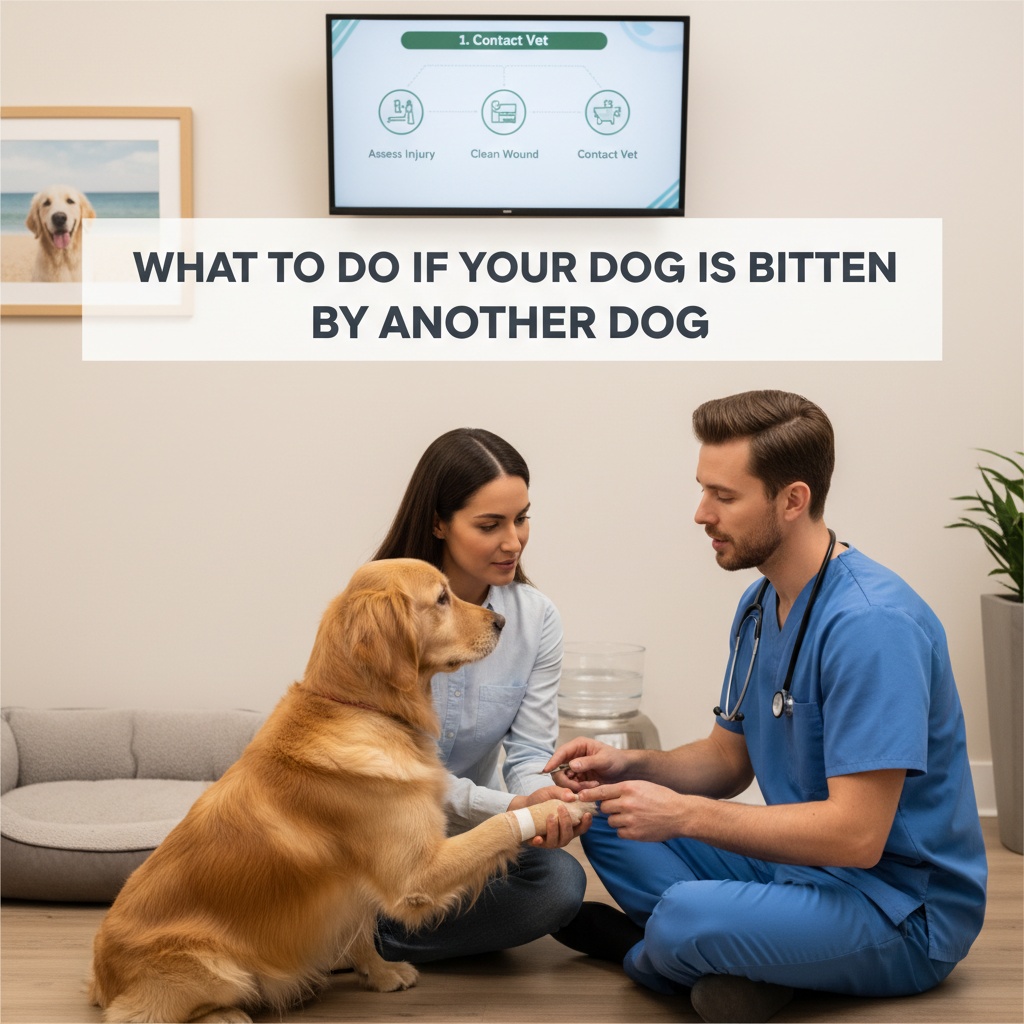What To Do If Your Dog Is Bitten By Another Dog
Estimated reading time: 5 minutes
- Always intervene safely and calmly.
- Prioritize veterinary care, regardless of how the wound seems.
- Be proactive about vaccinations and understanding dog behaviors.
Table of Contents:
- Act Fast: Initial Steps to Take
- The Critical Role of Veterinary Care
- Preparing for Future Incidents
- Practical Takeaways
- Conclusion
- FAQ
Act Fast: Initial Steps to Take
When faced with a dog bite incident, the quick reaction of the dog owner plays a vital role in minimizing damage and promoting recovery. Here’s what you need to do:
- Separate the Dogs Safely: First, ensure that both dogs are safely separated to avoid further injury. Do not place yourself in a position where you risk being bitten. Instead, use loud distractions, such as clapping, to redirect their attention without direct physical intervention (source: TKVES).
- Stay Calm and Comfort Your Dog: Your demeanor significantly affects your dog’s reaction to stress. A calm presence can help reduce your dog’s fear and anxiety during such a traumatic situation (source: Mills Animal Hospital).
- Exchange Information with the Other Dog’s Owner: It’s essential to gather the contact details of the other dog’s owner and obtain vaccination history, especially for rabies (source: Healthline). If the other dog is unaccompanied, seek witnesses who might know the owner.
- Assess Your Dog’s Injuries: Look for visible wounds, lacerations, or signs of pain, such as limping or whining. Bites can often cause injuries that are not immediately evident, including muscle or nerve damage or internal bleeding (source: Mills Animal Hospital).
- Administer First Aid: For bleeding wounds, use a clean cloth and apply firm pressure to stop the bleeding. Minor wounds can be rinsed gently with warm water and mild soap, then covered with a sterile bandage. Avoid excessive cleaning of deeper wounds, which can lead to more tissue damage (source: BSW Health).
- Seek Veterinary Attention Immediately: Regardless of the wound’s apparent severity, contacting a vet promptly is crucial. Dog bites can cause deeper tissue injuries and pose a high risk of infection (source: Mills Animal Hospital); (source: TKVES). Severe wounds or persistent bleeding necessitate urgent emergency care.
The Critical Role of Veterinary Care
Dog bites are notorious for introducing bacteria deep into the skin, which can lead to rapid infections that may become life-threatening if untreated (source: Mills Animal Hospital). A veterinarian will thoroughly assess your dog, checking for physical trauma and performing necessary treatments, including cleaning, suturing, and administering antibiotics.
In addition, it is vital to follow all post-visit instructions regarding wound care, medications, and any follow-up appointments.
Signs of Infection to Monitor
After a dog bite, vigilance is key. Keep an eye out for signs of infection, including:
- Redness and swelling around the wound
- Increased heat or pain in the area
- Odor or pus developing from the site
- Changes in behavior, such as lethargy or reluctance to eat
If any of these symptoms appear, contact your veterinarian immediately (source: BSW Health).
Preparing for Future Incidents
While we can’t prevent every dog altercation, there are proactive steps you can take to mitigate risks:
- Ensure Vaccinations Are Up-to-Date: Regular check-ups and vaccinations, particularly against rabies, can protect your dog and others in the community (source: Healthline).
- Understand Your Dog’s Behavior: Familiarize yourself with your dog’s social dynamics and stressors. This awareness can help you manage situations more effectively in the future.
- File Incident Reports: If the other dog displays concerning aggression or if required by local law, consider filing an incident report with animal control authorities (source: Healthline). It helps document the occurrence and may provide insight into the biting dog’s history.
- Educate Yourself on Dog Behavior: Understanding dog behavior and body language enhances your ability to act quickly and appropriately in stressful situations.
Practical Takeaways
For dog owners, being knowledgeable about the appropriate steps to take when a dog bite occurs is invaluable. Here are key takeaways to remember:
- Always intervene safely and calmly.
- Prioritize veterinary care, regardless of how the wound seems.
- Be proactive about vaccinations and understanding dog behaviors.
Conclusion
Dog bites are distressing incidents, but with the right approach, you can manage the situation effectively. Understanding the immediate steps for care, the importance of veterinary support, and preventive measures can safeguard your dog’s health and well-being in the long run.
If you have further questions on pet care or need assistance with training and consultation, feel free to explore our services or contact us for more personalized advice. Your dog’s safety and happiness are our top priorities!
FAQ
What should I do immediately after my dog gets bitten?
Immediately separate the dogs, assess your dog’s injuries, administer first aid, and seek veterinary attention if needed.
How can I tell if my dog’s bite wound is infected?
Look for signs such as redness, swelling, heat, pus, or changes in behavior.
How often should my dog be vaccinated?
Generally, dogs should have regular check-ups and vaccinations as recommended by your veterinarian, particularly against rabies.
